
Source: Chainalysis; Compilation: White Water, Bit Chain Vision Realm
CNWE (CNWE) is the second largest cryptocurrency economy in the world after North America. From July 2023 to June 2024, the chain value reached US $ 987.25 billion, accounting for 21.7%of global transactions.CNWE’s cryptocurrency activities in most countries/regions are growing, with an average year -on -year growth rate of 44%.UK is still the largest cryptocurrency economy in CNWE, receiving $ 217 billion in cryptocurrencies, Ranked 12th among our global cryptocurrencies.
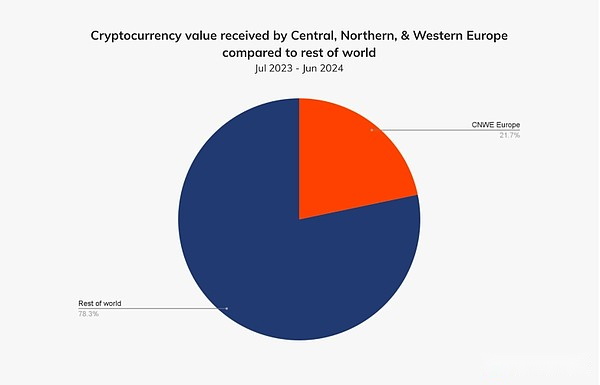

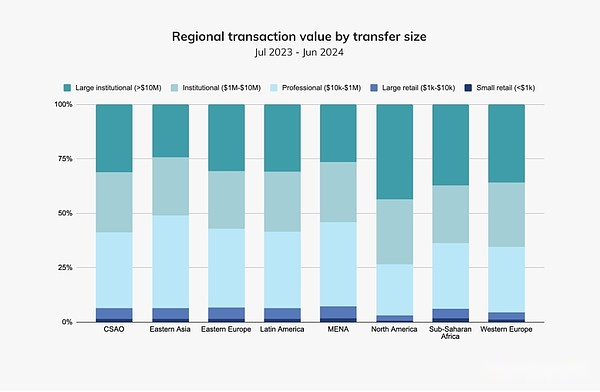
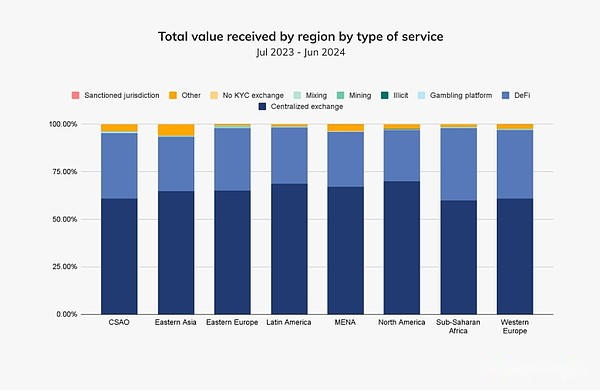
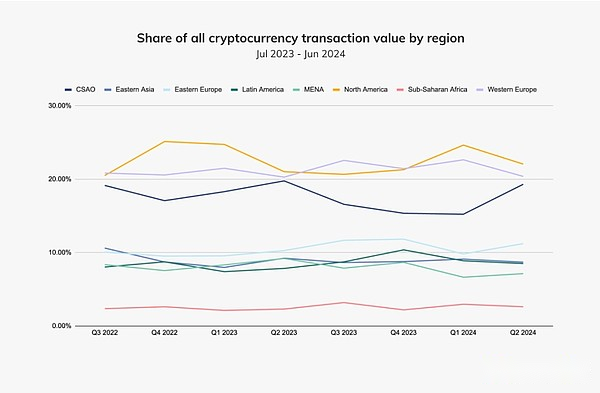
For transactions below $ 1 million, that is, professional ($ 10,000 to $ 1 million) and retail (& LT; $ 10,000) transfer, Bitcoin (BTC) has increased by nearly 75%, which is the highest among all types of assets in CNWE.of.Among all transactions, BTC accounts for US $ 212.3 billion (about one -five -fifth) received by the total value received on the CNWE chain.Although the growth rate of the BTC activity of the CNWE of 1 million US dollars is lower than that of North America (as shown in the figure below), the former has exceeded the latter in terms of the growth of all other asset types (especially stablecoins).
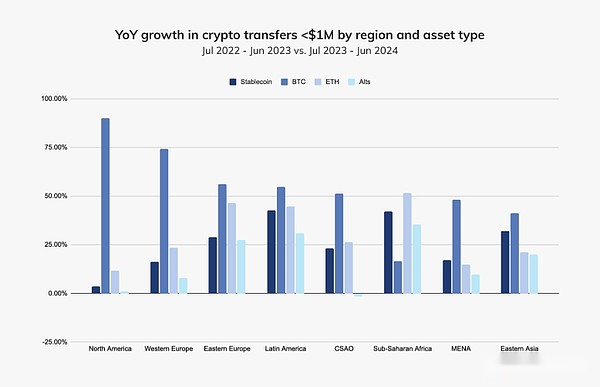
For transfers below $ 1 million, CNWE found that the increase in stable currency transaction volume was 2.5 times that of North America.The stable currency value of all transactions in CNWE accounted for almost half of its total cryptocurrency flow (US $ 422.3 billion).From the perspective of the average monthly inflow, the following figure shows the stable coin transfer performance of less than $ 1 million over the past year, with an average of $ 10 to 15 billion per month.
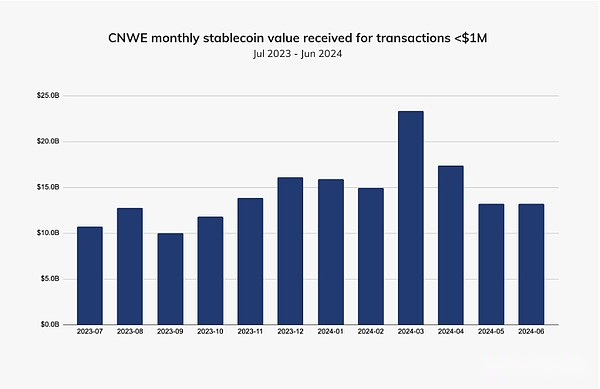
Although the inflows in May and June 2024 have decreased, the share of stable currency transactions has increased, which shows that although the market has declined after the market has declined, the use of stable coins is still strong.Further reviewing in the past two years, stable coins have dominated among other types of asset types.The picture below checks the purchase of less than $ 1 million in asset type.As we see, from July 2022 to June 2024, stablecoins accounted for 52.36% of the transactions of various types of asset types.

Last year, CNWE’s share of stable currency was far exceeded BTC.The figure below uses the order book data (list of assets or securities’s buying and selling orders) to supplement the event on the chain, and shows that the euro (EUR) occupies a 24% share in the purchase of stable currencies traded with legal currency transactions, but only 6 of BTC purchases only 6% Share.On the contrary, the US dollar (USD) has a larger share in BTC purchases than the share of stablecoin purchases.
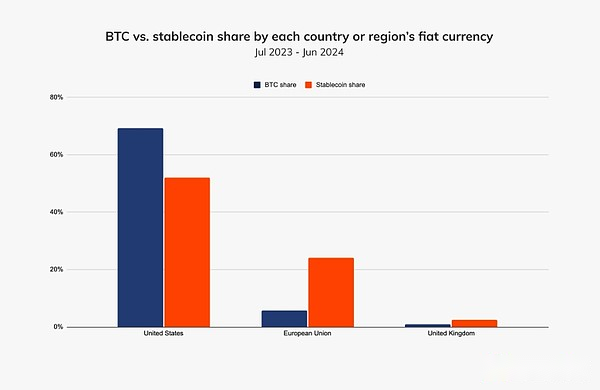
Data show that when cryptocurrency transactions involving legal currencies, CNWE users are more optimized for cryptocurrency users who purchase stable currencies than buying BTCs.
In order to understand more information about the region’s stable currency activities, we interviewed BVNK, which is a global company that provides stable coins to pay a multi -asset platform.Chris Harmse, co -founder and chief business officer of BVNK, said: “Our fiat currency business is serving our stable currency platform. We think they are coexisting and we need to meet the gap with the legal world.”
Harmse confirmed that the investigation results of Chainalysis on the use of stable coins in the region are consistent with the company’s observation results.BVNK’s commercial customers purchase stable coins to meet various payment cases.For consumers of these companies, 90% of their payments are carried out using stable coins.We will share more information about BVNK in the next section.
Business services are booming in the UK
CNWE has the second largest commercial service market in the world second only to CSAO, mainly promoted by Britain, with a year -on -year increase of 58.4%.
Stabilization currency is the most commonly used asset type in these services. Each quarter, it always occupies 60-80% of the market share, as shown in the figure below.
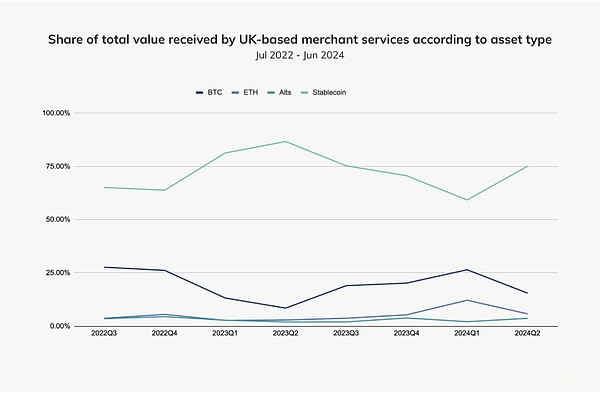
As one of the business service providers providing stable currency transactions for British and European companies, BVNK covers Consumer (B2B2C) use cases of B2B and B2B, such as the following examples:
-
Settlement:Fintech or payment service providers help merchants settle invoices to provide faster and cheaper payment channels than traditional finance (Tradfi).
-
Paid:When consumers want to use stable currency payment business (for example, deposit on trading platforms, recharge game or sports betting accounts, or buy online), BVNK’s corporate customers use API to provide encrypted payment gateways.
-
Payment:Monetary service enterprises (MSB) use stable currency payment contractors or employees. Many of them live in South America, experience currency depreciation, and/or cannot obtain US dollars.
Having said that, citizens with countries like Argentina (the inflation rate reached 143%in the second half of 2024) are turning to stable coins to reduce the impact of currency depreciation.
Harmse said:“In an emerging market, companies have begun to regard stable currency as replacement. Just as Argentina consumers cannot obtain US dollars in the market, enterprises are also hindered by traditional payment channels. They cannot pay invoices on time.Stable coins to make these payments to use the global trade flow. “
The average transaction scale that BVNK sees on its platform is between $ 100,000 and $ 250,000. Payment within this range is usually large commercial transactions for settlement invoices, as described above.Most of the B2B transactions processed by the company are cross -border payment, and most of them have stable currency payment to Latin America.The amount of consumers handled through the BVNK platform is between $ 100 and $ 1,000.
When asked about the new or surprising stable currency use cases, Harmse mentioned the small payment of the freelancer in the zero -working economy -similarly, these are usually cross -border payment, and the cost of traditional payment methods is too high.He also mentioned that the region began to see more non -profit organizations and non -governmental organizations using encrypted payment (especially stablecoin) during crisis to provide assistance to conflict areas faster.
Payhound is another company that provides business services in CNWE.It is a Malta’s encrypted payment processor that provides services for the country’s online game industry and provides settlement and large transactions.Although the latter is most of Payhound’s income, the company also recognizes the value and potential of its payment processing products.
“We believe that online companies will have a lot of interests to provide as many choices, especially more innovative payment methods,” said Elton Dimech, the managing director of Payhound.
The real -world asset token has attracted attention
This year, regional experts stated that although the real world assets (RWA) tokens are in the bud stage, they are getting attention in CNWE.Philipp Bohrn is the vice president of public and regulatory affairs in Bitpanda, a cryptocurrency exchange in Austria.“Throughout Europe, we have seen that the RWA’s tokenization project is becoming more and more popular, especially in the fields of real estate, intellectual property and art, car or wine,” “He said.
We also interviewed Sylvain Price, chief product officer of the Societe General-Forge (SG-FORGE) (SG-FORGE), is a subsidiary of the Societe General Group.SG-FORGE is paving the road for security tokens, especially the first digital green bond issuance registered directly on the Ethereum public blockchain last year, which improves the transparency and traceability of ESG data.Prigent believes that securities tokens and RWA will generally create accessible investment opportunities for the traditional competitive securities market.Prigent said that in order to enable this new infrastructure to smoothly use Tradfi, we have already carried out a lot of development.
CNWE DEFI growth rankings in the world fourth in the world
CNWE’s DEFI event has been the same as the global average.The region’s year -on -year growth performance is better than North America, East Asia and the Middle East, and North Africa, accounting for $ 270.5B of all cryptocurrencies received in the region.
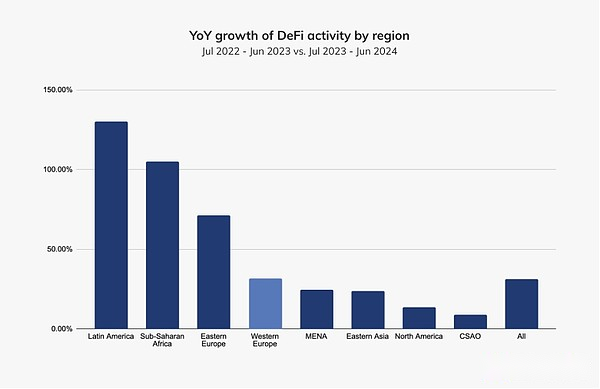
The decentralized exchange (DEX) has promoted CNWE’s Defi growth, while most other DEFI service categories have declined in recent quarters.In the first quarter of this year, the NFT and bridge connectors had a short -term surge, and then gradually faded and returned to the level of previous years.Loans rose in the fourth quarter of 2023, but in 2024, it fell steadily and has not yet rebounded.
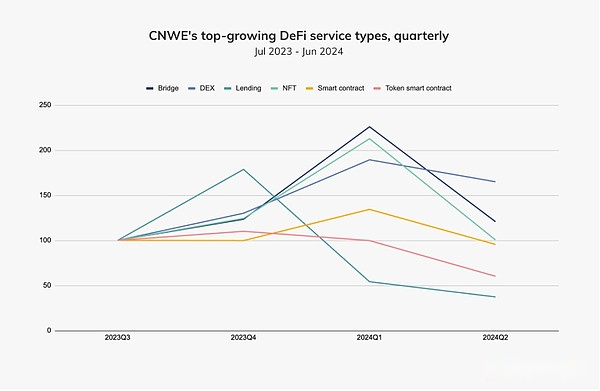
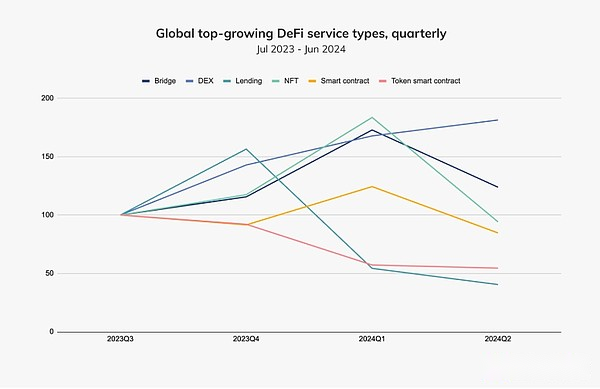
Although similar growth trends are reflected globally,CNWE’s DEFI growth rate is faster than the world.In CNWE, the growth rate of bridges and NFT is 2 times, while only 1.5 times in other parts of the world.
The future of cryptocurrencies in Central Europe, Nordic and Western European
This summer, the EU (EU) crypto asset market supervision (MICA) has taken effect in stable currency, and stabilization coins have continued to obtain market share in CNWE over the past year.However, the region has not yet felt Mica’s supervision of the supervision of crypto asset service providers (CASP), and this benchmark will take effect in December.We interviewed several experts on the impact of Mica’s potential supervision throughout the European Union.
Bitpanda’s Philipp Bohrn said:“One of the main challenges that still exist are the complexity of regulatory uncertainty and the complexity of cross -border compliance.”“There is still a gap between education. Many participants do not know how the tokens operate and what the benefits and risks that may bring. However, we have seen a huge opportunity here -through the influence of this knowledge gap and create a clear creation and create clearlyIn the regulatory framework, we can release the true potential of asset tokenization and promote the strong growth of innovation and global financial markets. “
Payhound’s Elton Dimech discusses how MICA affects payment processors, especially those payment processors that provide services to the online game industry for CNWE.”In Malta, we have a powerful framework that must compete with other companies that are almost no supervisory. Therefore, if the merchant wants to go out of the way, we will not be their correct choice. After MICA takes effect, this situation will be thoroughly situation.Change, I hope that the European Union’s internal regulatory agencies can implement this new rule so that we can provide a fair competitive environment for all crypto asset service providers. “
As Mica’s CASP rules will take effect in December, the compliance team will be at the forefront of enhancement of implementation and related control.Zodia Custody, headquartered in the UK, is a company that brings up the gap between Tradfi and cryptocurrency. The Group’s chief compliance officer Sophie Bowler also expresses the company’s point of view.
“We believe that supervision is the key to the mainstream of digital assets and further success and innovation,” Bowler said.“The clarity of supervision not only enables digital asset companies to develop new products with confidence, but also encourages more traditional financial institutions to participate in digital asset business within a clear regulatory framework.”
With the development of MICA in the European Union, Britain is also constantly developing its own regulatory framework.
Bowler said: “For companies that cannot be or unwilling to meet MICA requirements, they may turn to the British market in the short term.” “However, we think this will be temporary, because British encrypted legislation is expected to be closely combined with Mica, and FCA encrypted legislationThe scheme roadmap and related consultation documents are expected to be launched in early 2025, providing us with greater support.
In Chainalysis, we will monitor the final stage of Mica’s launch and the development of the United Kingdom, and eager to understand how these measures affect the use of cryptocurrencies in the coming year.








